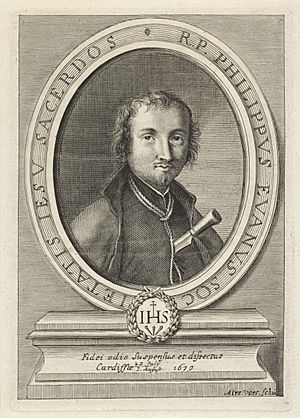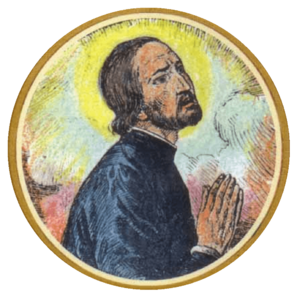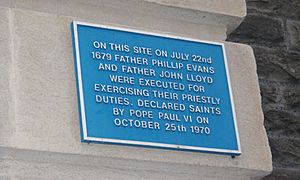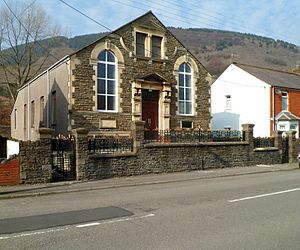Philip Evans and John Lloyd facts for kids
Philip Evans and John Lloyd were two Welsh Roman Catholic priests. They lived a long time ago, when being a Catholic priest in Wales was against the law. They are now remembered as two of the Forty Martyrs of England and Wales, who were people who died for their Catholic faith.
Contents
Philip Evans
Quick facts for kids SaintPhilip Evans S.J. |
|
|---|---|
 |
|
| Priest and Martyr | |
| Born | c. 1645 Monmouth, Wales |
| Died | 22 July 1679 (aged 33 - 34) Pwllhalog, near Cardiff, Wales |
| Venerated in | Roman Catholic Church |
| Beatified | 15 December 1929 by Pope Pius XI |
| Canonized | 25 October 1970 by Pope Paul VI |
| Feast | 23 July, 25 October |
| Attributes | noose around neck, knife in chest, harp |
| Patronage | Tennis, tennis players |
Philip Evans was born in Monmouth, Wales, around 1645. He went to school at the Jesuit College of St. Omer, which is now in France. In 1665, he joined a religious group called the Society of Jesus (also known as the Jesuits). He became a priest in Liège, which is now in Belgium. In 1675, he was sent to South Wales to work as a missionary priest.
Philip worked in Wales for four years. Even though being a Catholic priest was against the law, he was not arrested for a while. But then, a time of fear called the Oates' scare spread across the country. People became very suspicious of Catholics. In November 1678, a man named John Arnold, who hunted priests, offered a large reward of £200 for Philip's arrest.
Even with the danger, Philip Evans refused to leave the people he served. He was arrested at the home of Christopher Turberville in Glamorgan on December 4, 1678. It is thought that Christopher's brother, Edward Turberville, who was a well-known priest hunter, led the group that arrested him.
John Lloyd
John Lloyd was also a Welsh priest. He was a secular priest, which means he was not part of a specific religious order like the Jesuits. He was from Breconshire, Wales. He studied in Ghent, Belgium, and then at the English College, Valladolid, in Spain, starting in 1649. He promised to work as a missionary in England and Wales.
In 1654, John Lloyd was sent to Wales to help Catholics who had to practice their faith in secret. For 24 years, he lived as a priest, always on the run to avoid being caught. He was arrested at Turberville's house in Glamorgan on November 20, 1678. He was then put in Cardiff Gaol (jail). Soon after, Philip Evans was also brought to the same jail.
| Saint John Lloyd |
|
|---|---|
 |
|
| Priest and Martyr | |
| Born | Breconshire, Wales |
| Died | 22 July 1679 (aged 33 - 34) Pwllhalog, near Cardiff, Wales |
| Venerated in | Roman Catholic Church |
| Beatified | 15 December 1929 by Pope Pius XI |
| Canonized | 25 October 1970 by Pope Paul VI |
| Feast | 23 July, 25 October |
Their Trial
Both priests were put on trial in Cardiff on May 5, 1679. They were not accused of being part of the "Popish Plot" that caused so much fear. Instead, they were tried simply for being Catholic priests and for coming to England and Wales to practice their faith. This was against a law from 1584 called the Jesuits, etc. Act 1584. They were found guilty of treason just for being priests.
Their Executions
The executions were delayed for so long that it seemed they might not happen. The priests were even given a lot of freedom, sometimes leaving the prison for fresh air. However, the executions finally took place in Pwllhalog, near Cardiff, on July 22, 1679. Today, two plaques mark the spot where they died. This place is now the corner of Crwys Road and Richmond Road in Roath, Cardiff, and is still known as "Death Junction."
Philip Evans was executed first. He spoke to the crowd in both Welsh and English. He said to John Lloyd, ‘Goodbye, Father Lloyd! It's only for a little while, because we will meet again soon.' John Lloyd spoke very briefly, saying, ‘I was never a good speaker in my life.'
Becoming Saints
On October 25, 1970, both John Lloyd and Philip Evans were made saints by Pope Paul VI. Even though they died on July 22, that date is already a special day for Mary Magdalen in the Catholic Church. So, their shared feast day was set for July 23. This date is also the feast day for Bridget of Sweden. Because Bridget was later named one of the patron saints of Europe, churches usually celebrate her on July 23. Churches named after John Lloyd or Philip Evans can celebrate their feast day on July 23. Other churches can choose to celebrate them on a nearby date.
The special day for all Forty Martyrs of England and Wales used to be October 25. In England, they are now celebrated with other martyrs on May 4. In Wales, October 25 is the feast day for the "Six Welsh Martyrs and their companions".
Places Named After Them
St Philip Evans
- St Philip Evans Church, Llanedeyrn, Cardiff (Roman Catholic)
- St Philip Evans Catholic Primary School, Llanedyrn, Cardiff
- St Philip Evans Church, Cwmafan, Neath Port Talbot (Roman Catholic)
St John Lloyd
- St John Lloyd Church, Rumney, Cardiff (Roman Catholic)
- St John Lloyd Catholic Comprehensive School, Llanelli
- St John Lloyd R.C. Primary School, Trowbridge, Cardiff



